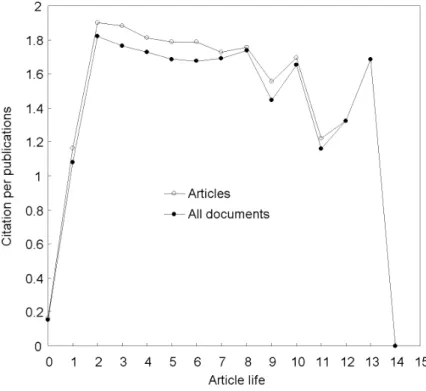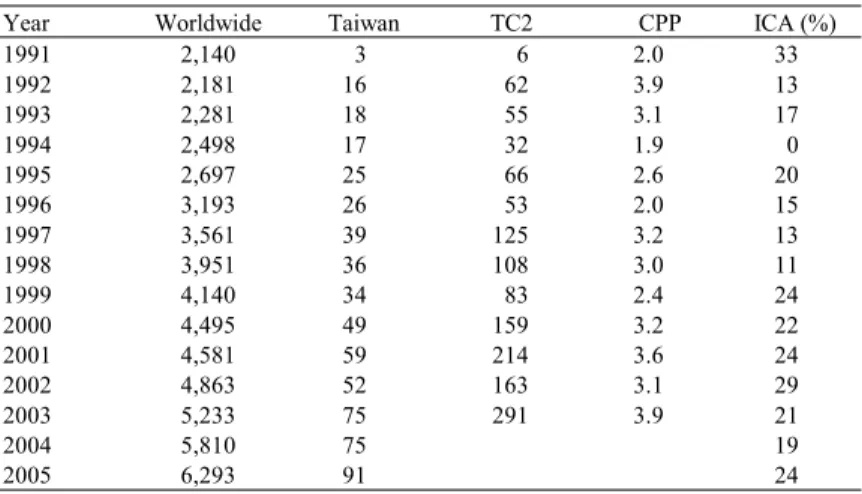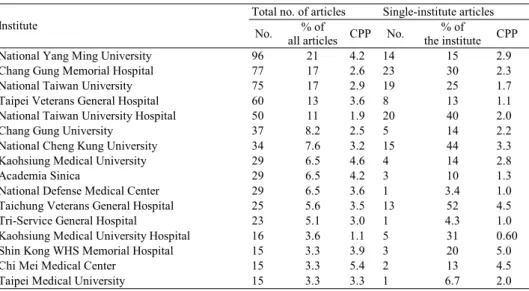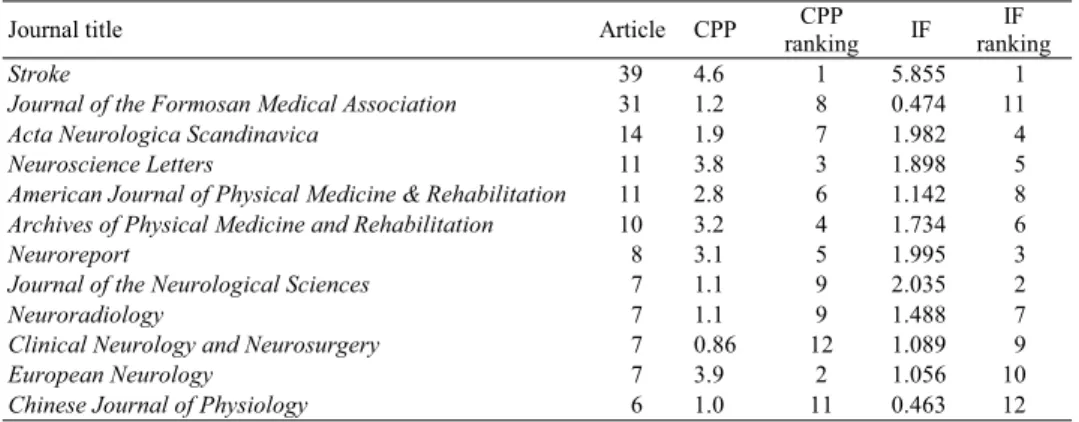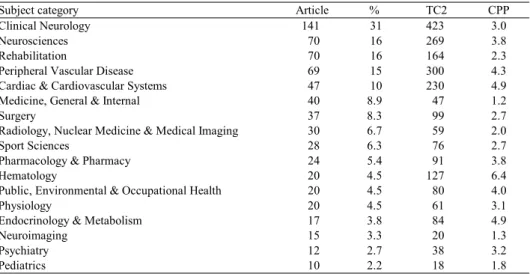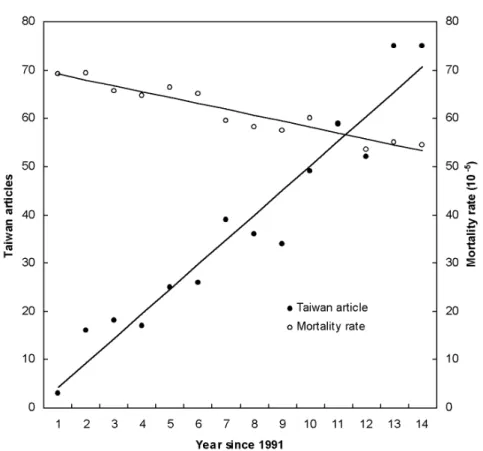Received August 31, 2006 Address for correspondence: YUH-SHAN HO
Bibliometric Center, Taipei Medical University, Wan-Fang Hospital, Taipei, Taiwan E-mail: ysho@tmu.edu.tw
A bibliometric and citation analysis
of stroke-related research in Taiwan
KUN-YANG CHUANG,a YA-LIHUANG,b YUH-SHAN HOc a Department of Public Health, Taipei Medical University, Taipei (Taiwan) b Division of Public Health, School of Medicine, Taipei Medical University, Taipei (Taiwan)
c Bibliometric Center, Taipei Medical University, Wan-Fang Hospital, Taipei (Taiwan)
As the population ages in Taiwan, stroke research has received greater attention in recent years. Strokes have significant impacts on the health and well-being of the elderly. To formulate future research policy, information on stroke publications should be collected. In this research, we studied stroke-related research articles published by Taiwan researchers which were indexed in the Science Citation Index from 1991 to 2005. We found that the quantity of publications has increased at a quicker pace than the worldwide trend. Over the years, there has been an increase in international collaboration, mainly with researchers in the U.S. Article visibility, measured as the frequency of being cited, also increased during the period. It appears that stroke research in Taiwan has become more globally connected and has also improved in quality. The publication output was concentrated in a few institutes, but there was a wide variation among these institutes in the ability to independently conduct research. A wide array of keywords indicated a probable lack of continuity in research. Nevertheless, there was an inverse relationship between stroke mortality and number of published articles in Taiwan. To improve the quality and efficiency of stroke research, continuity in research focuses needs to be maintained, and thus funding should be allocated on a long-term basis to institutes with a proven record of success.
Introduction
The average life expectancy at birth in Taiwan reached 79 years for females and 73 years for males in 2004. The percentage of elderly persons in Taiwan was forcaste to be
about 10% in 2006 and is expected to reach 20% by 2026 (COUNCIL FOR ECONOMIC
PLANNING AND DEVELOPMENT, 2004). As the population ages, more people, particularly the elderly, are suffering from chronic health conditions. Stroke is a chronic condition that leads to permanent disabilities, and has major impacts on medical care expenditures. Since 1994, it has been the 2nd leading cause of death in Taiwan. For the elderly, 11% of all deaths in 2004 were stroke-related (DEPARTMENT OF HEALTH, 2004a).
Stroke-related research has been conducted for many decades (FISHER, 1965; ROSS, 1993; SACKS et al., 1996; ROSSOUW et al., 2002). In Taiwan, a survey of deaths of patients with stroke was reported in earlier year (TSENG, 1982). Several stroke-related research reports were presented after that (LEE & HSIEH, 1986; LIU et al., 1992; KELLY
et al., 1992). As stroke research begins to further develop in Taiwan, information about stroke research will need to be collected before future research strategies can be formulated. Thus, in this study, we attempted to bibliometrically analyze the stroke literature published by Taiwanese researchers from 1991 to 2005, in order to provide insights into the characteristics of the stroke literature and identify patterns, tendencies, or irregularities that may exist in the literature. Furthermore, this will provide a comprehensive evaluation of current stroke research in Taiwan. Such information may have significant implications for research policy and resource allocation.
Methods
Data used in this research were obtained from the online version of the ISI Web of Science: SCI (Science Citation Index). All documents from 1991 to 2005 with “Taiwan” in the address field and which had the following keywords were downloaded: stroke, cerebral hemorrhage, cerebral thrombosis, cerebral embolism, subarachnoid hemorrhage, apoplexy, intracerebral hemorrhage, intracerebral hematoma, apoplectic, and cerebrovascular diseases. In total, 911 publications met the selection criteria. Upon further examination, only 823 publications were categorized as “articles”. The others were a bibliography (1), editorial materials (8), letters (8), meeting abstracts (53), notes (9), and reviews (9). In order to verify that these articles were stroke-related, investigators examined the content of abstracts for the 823 articles, and excluded articles that were not stroke-related despite being in accordance with the selection criteria. Many of the excluded articles used “stroke” in reference to computer key strokes from the field of computer science or pattern recognition, or two-stroke motorcycle engines. Some referred to heat stroke or stoke volume of cardiac function, but were not related to cerebrovascular studies. These articles were excluded and the final number of articles was 615.
Downloaded information included names of authors, contact address, title, year of publication, keywords, times cited, subject categories of the article, names of journals
publishing the articles, and publisher information. The records were downloaded into spreadsheet software, and additional coding was manually performed for the number of authors, country of origin of the collaborators, and impact factors of the publishing journals. Impact factors were taken from the Journal Citation Report (JCR) published in 2005.
To assess the visibility of an article, we used the number of times it was cited as an indicator. However, the numbers of times cited for an article is highly correlated with the length of time since its publication. To adjust for that, a new variable was created. Figure 1 shows the relationship between the average number of times cited per paper and the number of years since its publication for the 615 articles. It shows that the frequency of being cited was highest in the 2nd full year since its publication, and began to decrease thereafter. Thus, to adjust for bias due to differences in the length of time since publication, a new variable, TC2 (times cited before year 2), instead of just times cited since publication, was used to assess the visibility of articles. A TC2 for year 2000 would be the number to times being cited before the end of 2002 for all the articles published in 2000. Another variable CPP (citation per publication) for articles published in a particular year was calculated as TC2 divided by the number of articles published in that year.
Results
Article characteristics
The number of stroke-related articles published by Taiwanese researchers has significantly increased since 1991, as displayed in Table 1. There were 615 stroke-related articles published from 1991 to 2005. There were only 3 articles in 1991, but increased to 16 articles in 1992. After that, there has been a steady increase. In 2004, it reached 75 articles, and in 2005, it increased to 91 articles. The growth trends of stroke-related publications by Taiwanese researchers relative to worldwide stroke-stroke-related publications are displayed in Figure 2. Compared to the worldwide trend, the trend in Taiwan has increased at a quicker pace. If looking at only the past 10 years (1996~2005), the annual number of publications worldwide increased by 97% from 3,193 to 6,293 articles, while that in Taiwan increased by 250% from 26 to 91 articles during the same period.
Figure 2 indicates that the rate of the annual increase in the number of articles has accelerated in recent years. Stroke-related research also outperformed overall scientific research in Taiwan. The number of scientific papers written by Taiwanese researchers in SCI journals increased from 8,944 papers in 1999 to 12,392 papers in 2003, an increase of about 39% (NATIONAL SCIENCE COUNCIL, 2004). During the same period, the number of stroke-related articles increased by about 120%.
Table 1. Article characteristics by year of publication
Year Worldwide Taiwan TC2 CPP ICA (%)
1991 2,140 3 6 2.0 33 1992 2,181 16 62 3.9 13 1993 2,281 18 55 3.1 17 1994 2,498 17 32 1.9 0 1995 2,697 25 66 2.6 20 1996 3,193 26 53 2.0 15 1997 3,561 39 125 3.2 13 1998 3,951 36 108 3.0 11 1999 4,140 34 83 2.4 24 2000 4,495 49 159 3.2 22 2001 4,581 59 214 3.6 24 2002 4,863 52 163 3.1 29 2003 5,233 75 291 3.9 21 2004 5,810 75 19 2005 6,293 91 24
TC2, times cited before the 2nd full year since publication; CPP, citation per publication; ICA, international co-authorship.
Table 1 also shows TC2 and CPP. Since TC2 and CPP were calculated based on the frequency of being cited before the 2nd full year of article life, articles published after 2004 would not have TC2 or CPP values. Thus, only 449 articles had a CPP value. Table 1 shows that CPP has fluctuated over the years. The average CPP was 3.2. The CPP was lowest in 1994, 1991, and 1996 at 1.9, 2.0, and 2.0, respectively, but was highest in 2003, 1992, and 2001 at 3.9, 3.9, and 3.6, respectively. Using 3-year periods to minimize the year-to-year fluctuations, the average CPP values for 1992~1994, 1995~1997, 1998~2000, and 2001~2003 were 2.9, 2.7, 2.9, and 3.6, respectively. It appeared that the visibility of research articles published after 2000 have significantly increased compared to articles published in previous years.
International collaboration
Of the 615 articles, 124 articles, or about 20%, had international co-authorship (ICA). The percentage of articles with ICA is listed in Table 1. The percentage of ICA articles was highest in 1991 at 33%, followed by 2002 at 29%, and 1999, 2001, and 2005 at 24%. In general, ICA articles were more prevalent in recent years than earlier
years. Using 5-year intervals, the percentages of articles with ICA were 14%, 17%, and 23% for the periods 1991~1995, 1996~2000, and 2001~2005, respectively.
It appeared that papers with ICA had higher visibility than others. Of the 615 articles, 449 had a CPP value. Among them, 88 articles had an ICA. These articles had an average CPP of 4.9, while the others had an average CPP of 2.7. ICA articles had significantly higher CPP values, and t-tests revealed that the difference was statistically significant at the p = 0.05 level. Table 2 shows the number of articles with ICA and CPP values for countries that had co-authored papers with Taiwanese researchers. The country with the most co-authorship was the US with 75 articles, comprising 85% of the total number of internationally co-authored articles. These 75 articles had an average CPP of 4.9. Japan was the country with the 2nd most number of collaborations with 6 articles and an average CPP of 6.3. The other countries included the UK (4), Canada (3), and France (3). ICA articles with the highest CPP values were co-authored with researchers from Hong Kong and China. These articles had an average CPP of 7.0. Taiwan, being in close geographical proximity with Japan, Hong Kong, and China, should consider increasing its research collaboration with them. Japan experienced the demographic transition and population aging much earlier than Taiwan. Furthermore, CPP values of these co-authored articles were much higher than those co-authored with the US. It is likely that stroke research in Taiwan will benefit from more collaboration with the Japanese.
Table 2. International collaboration by country Co-authorship country Number of articles % of co-authored papers CPP USA 75 85 4.9 Japan 6 6.8 6.3 UK 4 4.5 5.8 Canada 3 3.4 4.7 France 3 3.4 4.0 New Zealand 2 2.3 10 Hong Kong 2 2.3 7.0 Austria 2 2.3 5.5 Australia 2 2.3 3.5 China 1 1.1 7.0 Italy 1 1.1 5.0 Slovakia 1 1.1 5.0 South Korea 1 1.1 3.0 Germany 1 1.1 1.0 N = 88; CPP, citations per publication.
Institutional comparisons
Table 3 shows the number of articles and the number of single-institute articles for institutes that had published at least 15 articles since 1991. Of the 449 articles, 161 were
published by a single institute. Some institutes have changed their status form a college to a university since 1991, and data for these institutes were grouped together under the new name. For instance, since National Yang Ming Medical College changed its name to National Yang Ming University, articles published under both institutional names were grouped together under the university’s name. In Table 3, the institutes are listed in descending order of the number of total articles published. National Yang Ming University (NYMU) had the most number of publications with 96 articles, followed by Cheng Gung Memorial Hospital (CGMH) with 77 articles. National Taiwan University (NTU) with 75 articles, Taipei Veterans General Hospital (TVGH) with 60 articles, National Taiwan University Hospital (NTUH) with 50 articles, and Chang Gung University (CGU) with 37 articles made up the other 4 of the top 6 institutes.
Table 3. Institutional comparisons
Total no. of articles Single-institute articles Institute
No. % of
all articles CPP No.
% of
the institute CPP National Yang Ming University 96 21 4.2 14 15 2.9 Chang Gung Memorial Hospital 77 17 2.6 23 30 2.3 National Taiwan University 75 17 2.9 19 25 1.7 Taipei Veterans General Hospital 60 13 3.6 8 13 1.1 National Taiwan University Hospital 50 11 1.9 20 40 2.0 Chang Gung University 37 8.2 2.5 5 14 2.2 National Cheng Kung University 34 7.6 3.2 15 44 3.3 Kaohsiung Medical University 29 6.5 4.6 4 14 2.8 Academia Sinica 29 6.5 4.2 3 10 1.3 National Defense Medical Center 29 6.5 3.6 1 3.4 1.0 Taichung Veterans General Hospital 25 5.6 3.5 13 52 4.5 Tri-Service General Hospital 23 5.1 3.0 1 4.3 1.0 Kaohsiung Medical University Hospital 16 3.6 1.1 5 31 0.60 Shin Kong WHS Memorial Hospital 15 3.3 3.9 3 20 5.0 Chi Mei Medical Center 15 3.3 5.4 2 13 4.5 Taipei Medical University 15 3.3 3.3 1 6.7 2.0 N = 449; CPP, citations per publication.
All of the top 6 institutes are located in northern Taiwan, indicating the presence of geographical disparity in stroke research. Among the top 6 institutes, 3 were universities and 3 were hospitals. The 3 hospitals had some common characteristics. All of them were medical centers with strong ties to a university. CGMH and NTUH are affiliated with CGU and NTU respectively. Although not formally affiliated with a university, TVGH does have a close working relationship with NYMU due to their close proximity in location. Nevertheless, it seems that in terms of stroke-related research, hospitals also performed very well.
While NYMU may have led in the number of articles, its ability to independently conduct research lagged far behind other institutes. Only 14 articles (15%) were single-institute articles, compared to 20 articles (40%) for NTUH, 19 articles (25%) for NTU.
The combined percentage of single-institute articles for the 3 hospitals was 27%, much higher than the 18% for the 3 universities. It appears that hospitals are more inclined or able to conduct research independently. Normally, if an institute is not able to conduct research independently, it will have difficulty amassing research outputs, unless it has extensive research networks and many collaborators. To find out how NYMU formed its research network would require further investigation and is beyond the scope of this paper. In terms of CPP values for single-institute articles, NYMU leads the other institutes with 2.9, followed by CGMH (2.3), CGU (2.2), NTUH (2.0), NTU (1.7), and TVGH (1.1). Comparisons showed that the 3 universities had an average CPP of 2.2, which little differed from the average CPP of 2.1 for the 3 hospitals.
Journals, subject categories, and keywords
Table 4 shows the names of journals, number of articles published by these journals, CPP, ranking order of CPP, IF, and ranking order of IF. The journal that published the greatest number of articles by Taiwanese researchers was Stroke with 39 articles, followed by Journal of the Formosan Medical Association (31), Acta Neurological
Scandinavia (14), Neuroscience Letters (11), American Journal of Physical Medication and Rehabilitation (11), Archives of Physical Medicine and Rehabilitation (10), and Neuroreport (8). The 39 articles published in Stroke had the highest average CPP (4.6)
and the highest IF (5.855) among the 12 journals listed in Table 4. However, the
Journal of Formosan Medical Association which published the 2nd most number of articles had a CPP of 1.2, and an IF of 0.47, ranked 8th and 11th respectively out of the 12 journals listed in Table 4. Contrary to what was expected, for articles published by Taiwanese researchers, the relationship between CPP and IF was weak.
Table 4. Journals publishing Taiwanese articles
Journal title Article CPP CPP
ranking IF IF ranking
Stroke 39 4.6 1 5.855 1
Journal of the Formosan Medical Association 31 1.2 8 0.474 11
Acta Neurologica Scandinavica 14 1.9 7 1.982 4
Neuroscience Letters 11 3.8 3 1.898 5
American Journal of Physical Medicine & Rehabilitation 11 2.8 6 1.142 8 Archives of Physical Medicine and Rehabilitation 10 3.2 4 1.734 6
Neuroreport 8 3.1 5 1.995 3
Journal of the Neurological Sciences 7 1.1 9 2.035 2
Neuroradiology 7 1.1 9 1.488 7
Clinical Neurology and Neurosurgery 7 0.86 12 1.089 9
European Neurology 7 3.9 2 1.056 10
Chinese Journal of Physiology 6 1.0 11 0.463 12
Two journals worth noting were Journal of Neurological Science which ranked 2nd in IF but only 9th in CPP, and European Neurology which ranked 10th in IF but 2nd in CPP. In other words, for Taiwanese articles, the number of times being cited is not associated with the impact factor of journals that publish these articles.
The articles were included in 105 subject categories. Table 5 shows the categories that had at least 10 articles. The five top categories with the most number of articles were Clinical Neurology (141), Neurosciences (70), Rehabilitation (70), Peripheral Vascular Disease (69), and Cardiac & Cardiovascular Systems (47). The categories with the top 5 CPP values were Hematology (6.4), Cardiac & Cardiovascular Systems (4.9), Endocrinology & Metabolism (4.9), Peripheral Vascular Disease (4.3), and Public, Environmental & Occupational Health (4.0).
Examination of author keywords revealed that 1,109 keywords were used. Among them, 891 keywords appeared only once, 118 keywords appeared only twice, and 47 keywords appeared only three times. The large number of once-only author keywords probably indicates a lack of continuity in research and a wide disparity in research focuses. Table 6 shows keywords that appeared at least 10 times. The most frequently used keyword was “stroke”, appearing in 19.0% of articles. The 2nd most frequently used keywords were “rehabilitation” at 4.2%, a significant drop from 19.0%. What can be concluded is that only 19% of the authors felt that their research was highly associated with strokes. This is probably an indication that most of the research articles were not considered to be mainstream stroke research by their authors.
Table 5. Number of articles and CPP by subject category
Subject category Article % TC2 CPP
Clinical Neurology 141 31 423 3.0
Neurosciences 70 16 269 3.8
Rehabilitation 70 16 164 2.3
Peripheral Vascular Disease 69 15 300 4.3 Cardiac & Cardiovascular Systems 47 10 230 4.9 Medicine, General & Internal 40 8.9 47 1.2
Surgery 37 8.3 99 2.7
Radiology, Nuclear Medicine & Medical Imaging 30 6.7 59 2.0
Sport Sciences 28 6.3 76 2.7
Pharmacology & Pharmacy 24 5.4 91 3.8
Hematology 20 4.5 127 6.4
Public, Environmental & Occupational Health 20 4.5 80 4.0
Physiology 20 4.5 61 3.1
Endocrinology & Metabolism 17 3.8 84 4.9
Neuroimaging 15 3.3 20 1.3
Psychiatry 12 2.7 38 3.2
Pediatrics 10 2.2 18 1.8
Table 6. Frequency of keywords used
Author keyword No. of articles % TC2 CPP
Stroke 72 19 285 4.0 Rehabilitation 16 4.2 35 2.2 Cerebral ischemia 14 3.7 65 4.6 Ischemia 14 3.7 60 4.3 Cerebrovascular disorders 14 3.7 42 3.0 Hypertension 13 3.4 45 3.5 Subarachnoid hemorrhage 13 3.4 21 1.6 Melas 11 2.9 34 3.1
TC2, times cited before the 2nd full year since publication; CPP, citation per publication.
Stroke mortality and quantity of articles
In 1991, stroke mortality in Taiwan was 69.11 per 100,000 persons.
The number decreased to 59.56 in 1997, and dropped further to 54.48 in 2004 (DEPARTMENT OF HEALTH, 2004b). As displayed in Figure 3, an inverse relationship between the number of articles and stroke mortality was observed.
As the number of published articles increased, the mortality rate decreased. Non-parametric statistical analysis showed that the mortality rate and number of publications had a Spearman’s rho of –0.896, and was statistically significant at the p < 0.001 level. Many factors, such as demographic composition, health care delivery and expenditures, health promotion initiatives, and other public health interventions, may have contributed to the decrease in stroke mortality rate over the years. Increases in stroke-related publications may have contributed to the decrease in mortality by increasing awareness of stroke, fostering more-positive attitudes towards prevention, and disseminating innovations in medical care. The exact magnitude of its effect on stroke mortality is not clear and more research is needed to assess its effect.
Discussion
Stroke-related scientific research in Taiwan has increased significantly over the last 15 years. Such growth is consistent with socio-demographic trends in Taiwan. As the population rapidly ages, and as stroke becomes the 2nd leading cause of death, Taiwan has been devoting more funding and more efforts to stroke research. Compared to the worldwide trend, it has increased at a much quicker pace. One reason could be that stroke research in Taiwan, unlike the global stroke research, is a recent phenomenon and is at an earlier stage with much room for growth. Thus, it increased at a quicker pace relative to the worldwide trend in which stroke research has begun much earlier in the developed countries.
The overall quality of articles, based on the impact factor of journals publishing those articles, appeared to be quite good. A substantial number of articles were published in 1st-tier journals, such as Stroke. Furthermore, the overall quality of research appeared to be improving, as indicated by an increase in CPP values of recently published articles. The numbers of articles with international co-authorship have increased over the years, and had significantly higher CPP values than the others. It would be reasonable to assume that more international collaboration would lead to more output due to the sharing of ideas and workloads. Since most of the SCI journal publishers were located in the US or Europe, and most of the papers were written in English, international collaboration would give Taiwanese researchers more information on topics that would be of interests to these journals. Furthermore, working with someone whose native language is English would also increase the efficiency and quality of writing, and hence, increase the chances of being published.
While these were positive aspects of stroke-related research in Taiwan, there were also some signs for concerns. There was an over-reliance on the US. Reliance on the US
as a collaborator, although having proven to be successful, may limit future development of research in Taiwan. Taiwan should try to increase its collaboration with other countries such as Japan given its close proximity and excellent quality of research output. Another sign of concern is that stroke research in Taiwan covers a wide range of sub-topics, as indicated by the large number of one-time-only author keywords used in these articles. These are probably indications that there is a lack of continuity in stroke research. Lack of continuity in research will likely hinder efforts to improve the quality of research and may also lead to inefficient use of research resources. In developing stroke-related research in the future, more emphasis should be placed on increasing the continuity of research by providing consistent funding for research and training programs. With limited resources, funding should be allocated wisely. Thus, in order to improve the quality and efficiency of research, funding should aim at supporting institutes that have a proven record of success in publishing stroke-related scientific articles, either independently or through international collaborations.
References
COUNCIL FOR ECONOMIC PLANNING AND DEVELOPMENT (2004), Projections of the Population of Taiwan Area, Republic of China 2004–2051. Executive Yuan, R.O.C.
DEPARTMENT OF HEALTH (2004a), Main Causes of Death in Taiwan. Retrieved June 14, 2006, from
http://www.doh.gov.tw/statistic/english/2/5.xls
DEPARTMENT OF HEALTH (2004b), Health and National Health Insurance Annual Statistics Information Service in Taiwan. Retrieved June 14, 2006, from http://www.doh.gov.tw/statistic/index.htm
FISHER, C. M. (1965), Pure sensory stroke involving face arm and leg. Neurology, 15 (1) : 76–80.
KELLY, R. P., TING, C. T., YANG, T. M., LIU, C. P., MAUGHAN, W. L., CHANG, M. S., KASS, D. A. (1992), Effective arterial elastance as index of arterial vascular load in humans. Circulation, 86 (2) : 513–521. LEE, T. K., HSIEH, B. S. (1986), Effect of acetylsalicylic-acid on urinary-excretion of prostaglandin-E in
stroke patients. Prostaglandins, 32 (6) : 847–855.
LIU, C. K., MILLER, B. L., CUMMINGS, J. L., MEHRINGER, C. M., GOLDBERG, M. A., HOWNG, S. L., BENSON, D. F. (1992), A quantitative MRI study of vascular dementia. Neurology, 42 (1) : 138–143.
NATIONAL SCIENCE COUNCIL (2004), Indicators of Science and Technology, Taiwan. Taipei: National Science Council.
ROSS, R. (1993), The pathogenesis of atherosclerosis – A perspective for the 1990s. Nature, 362 (6423) : 801–809.
ROSSOUW, J. E., ANDERSON, G. L., PRENTICE, R. L., LACROIX, A. Z., KOOPERBERG, C., STEFANICK, M. L., JACKSON, R. D., BERESFORD, S. A. A., HOWARD, B. V., JOHNSON, K. C., KOTCHEN, M., OCKENE, J. (2002), Risks and benefits of estrogen plus progestin in healthy postmenopausal women – Principal results from the Women’s Health Initiative randomized controlled trial. JAMA – Journal of the American Medical Association, 288 (3) : 321–333.
SACKS, F. M., PFEFFER, M. A., MOYE, L. A., ROULEAU, J. L., RUTHERFORD, J. D., COLE, T. G., BROWN, L., WARNICA, J. W., ARNOLD, J. M. O., WUN, C. C., DAVIS, B. R., BRAUNWALD, E. (1996), The effect of pravastatin on coronary events after myocardial infarction in patients with average cholesterol levels. New England Journal of Medicine, 335 (14) : 1001–1009.
TSENG, W. P. (1982), A survey on deaths of patients with stroke. Japanese Circulation Journal-English Edition, 46 (6) : 638–640.
